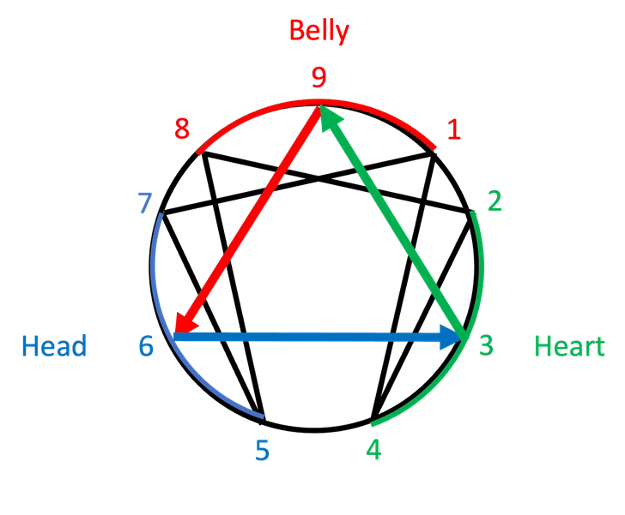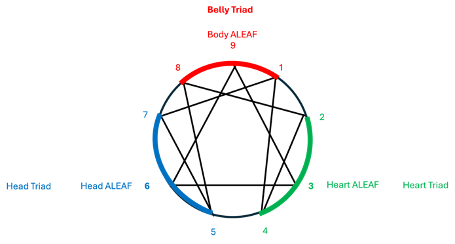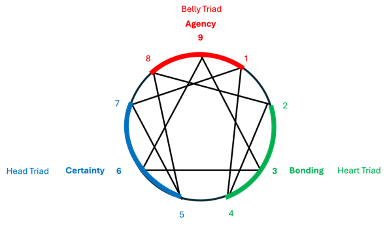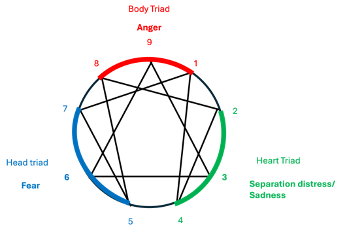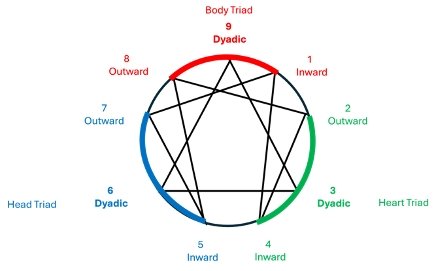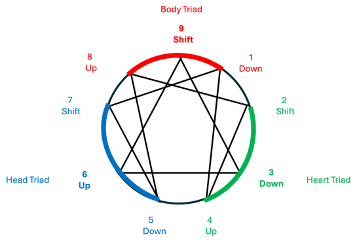The Patterns of Developmental Pathways Model, Part Two
An Interpersonal Neurobiological perspective on the Enneagram
In 2024 Dan Siegel, Laura Baker, David Daniels (posthumously), Denise Daniels and Jack Killen published Personality and wholeness in therapy; Integrating 9 patterns of developmental pathways in clinical practice.1
In this book, the “PDP Group”, as the authors collectively refer to themselves, presents a full description of their “Patterns of Developmental Pathways” model - an expansion of the model first outlined by Killen in 2009. The group had formed with the aim of creating a model of the Enneagram based on theory and research drawn from interpersonal neurobiology (IPNB). IPNB is “… an interdisciplinary framework for understanding the mind and mental health.”2
The PDP Group explicitly rejects a categorical typology model of the Enneagram. Instead, their model describes what have traditionally been referred to as the Enneagram types as, “patterns of developmental pathways”.3 The PDP model describes these patterns as being comprised of “…three motivational systems combined with three attentional orientations…”.4 Each PDP denotes, “[a] pattern of personality [that] arises in an individual when one developmental pathway and its adaptive strategy becomes especially dominant as a recurrent and habitual way of responding...".5
In constructing their model the PDP Group began with descriptions of the nine Enneagram types that David Daniels and Helen Palmer had developed over decades of interviewing representatives of each type about their lived experiences. (David Daniels’ book The Essential Enneagram provides a distillation of all these interviews in the form of paragraph length statements that convey a sense of the lived experience of each type.6). Essentially, the group worked backwards from Daniels’ descriptions to ask: What might be going on first at the genetic/temperament level (including before birth) and later at the interpersonal level (the child developing within a family environment) and still later at the intrapersonal level (different types experiencing themselves as both separate from and connected to others) that would account for the development and expression of these nine different patterns of being in the world?
Similarly to the Ichazo, Naranjo, and Palmer models, the PDP model conceptualizes the Enneagram patterns in terms of adaptive survival strategies. However, the PDP model expands on these earlier Enneagram models by including a consideration of what might be happening at the genetic level that affects the development of the type patterns. The PDP group conceptualizes the nine Enneagram patterns as developing out of an interaction between a child’s temperament and the environment that the child is born into (especially the near environment of the family). As they write, “The PDP model posits that infant temperament and early life experiences shape the differences in the relative activation of specific subcortical motivational circuits that then create enduring patterns in what has priority in our mental life as development unfolds…”7 .
The PDP Centers/Triads typology
The PDP Group does not use traditional term “centers” in their model, preferring instead to refer to “triads”. However, a core purpose of their model is to better understand the Enneagram centers. The PDP Group explains, “The PDP framework provides an IPNB-based hypothesis for understanding why the traditional Enneagram system groups patterns according to what are known as the body, heart, and head centers of intelligence.”
Components of the PDP triad construct
The PDP model is comprised of five components: ALEAFs, Vectors, Core Aversive Emotions, Attendencies, and Emotion Regulation Modes.
In this model, each triad varies in terms of ALEAFS, Vectors, and Core Aversive Emotions. The personality patterns within each triad vary in terms Attendency style and Emotion Regulation Mode.
The PDP model does not make use of the Enneagram symbol. The diagrams included below are my own mapping of the PDP components onto the traditional Enneagram system.
ALEAFs
“ALEAF” stands for “anatomical locations of energy activation and flow”.8 The PDP model uses the ALEAF component instead of the traditional Enneagram construct of “centers of intelligence”. As they explain: “… when the Enneagram uses the term ‘intelligence’, it is referring to how the world is perceived and how knowledge about the world is gained… we do not view these associations of physical experience as meaning the primary physical location of information processing is in these locations, such that the agency system is in the so-called ‘gut brain’ or the bonding system is in the so-called ‘heart brain’…”.9
Instead, the PDP model proposes that each of the three traditional Enneagram triads is distinguished by a specific ALEAF. ALEAFs are thought to provide information to the mind about the state of different parts of the human system. The PDP Group writes that ALEAFs, “…are likely a part of, but not the central information-processing regions for, each of the vector’s systems of mind.” The group goes on to state that, “…these anatomical locations can help illuminate the characteristic reactivity associated with each vector.”10
The PDP Group describes the ALEAFs in terms of Stephen Porges’ Polyvagal Theory.11 In the PDP model the Head triad is associated with the “neuroception process” in which the nervous system is continually scanning for risk or threat; the Heart triad is associated with the vagal nerve system including social engagement processes; and the Belly triad is associated with the dorsal nerve system, including responses to experiences of helplessness.
Vectors (Embedded Motivational Systems)
In the PDP model each triad is associated with a specific vector. Vectors are embedded motivational systems that are activated by perceived threats to survival. When a vector is activated energy and attention are directed towards the threat and behavior is organized around doing something about the threat. The motivational system associated with the Body triad is called Agency (A); the system associated with the Heart triad is called Bonding (B); and the system associated with the Head center is called Certainty (C).
The PDP Group explains, “A vector includes the subcortical motivation network that initiates both a drive to satisfy fundamental needs and its accompanying primal affects; it also involves the extended neural pathways connecting to a wider range of subcortical and cortical processes to satisfy that drive… A vector will have a specific pattern of energy directed in pursuit of these needs, and will motivate a sense of striving to achieve satisfaction of those needs… A vector will involve activation of certain specific patterns of emotion, thinking, and ways of behaving that we propose are the underlying mechanisms of at least some aspects of what we call personality.”12
Primal Aversive Emotions
The PDP model proposes that activation of a vector is accompanied by a specific, though not necessarily consciously experienced, aversive emotion. Activation of the Agency vector is associated with anger; activation of the Bonding vector is associated with separation distress/sadness; and activation of the Certainty vector is associated with fear.
Attendencies
The PDP model distinguishes among three different “energy and information streams that the human mind works with as it allocates attention and energy according to changing circumstances. In the PDP model each of the three PDPs within a triad is categorized as either primarily attending to an “inward information stream” which is about the inside of the physically separate being (the inner world); an “outward information stream” which is about the world outside of the physically separate being (the outer world); or a “dyadic information stream” which moves back and forth between the outer and inner worlds.13
In the PDP model, the core point of each triad is categorized as having a dyadic attendency style, while the non-core points of each triad are categorized as having either an inward or outward attendency style.
Emotion Regulation Mode
The PDP model also distinguishes among three different modes of emotion regulation that serve to modulate energy and behavior that is activated as information comes to the person via the Attendencies.
The PDP model proposes that within each triad, one PDP has an upregulating style, one PDP has a downregulating style, and one PDP has a shifting style.
When a person is embodying the upregulated mode, emotions “are allowed to flow freely outward into behavioral expression”; when a person is embodying the downregulated mode, emotions are “channeled into more tempered, disciplined contained, reined-in, or guarded behavior expression…; finally, when a person is embodying a shift mode, emotions are shifted away from the current emotion (and accompanying motivational state) and towards a different emotional- motivational state. 14
Patterns of Movement in the PDP Model
Because the PDP model does not make use of the Enneagram symbol it does not address the patterns of movement component that is part of the traditional Enneagram personality typology.
Summary
In the previous post, we looked at Killen’s 2009 model which was essentially an early version of the 2024 PDP model. The 2009 model had two components: aversive emotion and emotional regulation style.
The PDP model expands on the 2009 model by adding three more components: ALEAFS, Vectors, and Attendencies.
Taken together, the two models represent decades of work by the PDP Group to create a model of the traditional Enneagram types (or patterns) based on principles of interpersonal neurobiology.
The centers typology embedded in the PDP model provides an interpersonal neurobiological understanding of the traditional Enneagram centers.
Siegel, D., Baker, L.A., Daniels, D.N., Daniels, D., and Killen, J. (2024). Personality and wholeness in therapy: Integrating 9 patterns of developmental pathways in clinical practice. W.W. Norton & Company.
Siegel et al., ibid, p xxiv.
Siegel et al., ibid, p 15.
Siegel et al., ibid, p 15.
Siegel et al., ibid, p. 99
Daniels, D. and Price, V. (2009). The Essential Enneagram: A Comprehensive Guide to Self-Understanding, Personal Development, and the Nine Personality Types for a Better Quality of Life. Harper.
Siegel et al., ibid, p. 6
Siegel et al., p. 52,
Siegel et al., ibid, p. 52
Siegel et al., ibid, pp. 51 - 52
Porges, S. (2011). The Polyvagal theory: Neurophysiological foundations of emotions, attachment, communication, and self-regulation. W.W. Norton & Company.
Siegel et al., ibid, pp. 44 - 45.
Siegel et al., ibid p. 82.
Siegel et al., p. 66.

